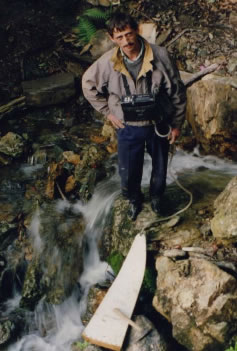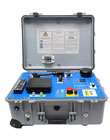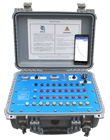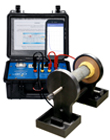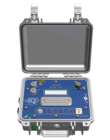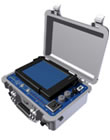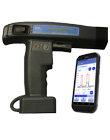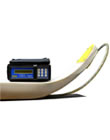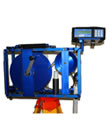DCH Geophysics
The following letter was submitted by DCH Geophysics after using the SCIP Tester on several field projects.
DCH Geophysics
Vancouver BC, CANADA 2015
The Sample Core I.P. Tester (SCIP), an important part of every exploration program
The SCIP continues to be a very useful tool to assist in the analysis of geophysical responses. At the early exploration stage, prior to geophysical surveys when the geologist or prospector is on the ground samples can be taken and measured using the SCIP to determine what type of geophysical survey should be contemplated in the search for mineralization. Depending on SCIP results, Induced Polarization or electromagnetic surveys may be carried out on a property and drill targets selected. Subsequently core samples can be analyzed using the SCIP to judge the effectiveness of the drilling and to obtain physical property values that can be used in modeling the mineralized body. In association with geochemical analysis SCIP testing will also aid in determination of the relationship between geophysical and geochemical responses. This will guide additional drill targeting.
In short, SCIP analysis is useful at every stage. The instrument is highly portable and a technician who is part of a drill program can be readily trained on SCIP use. The cost is modest and it should be part of every exploration program.
I have been using the SCIP for a number of years as a consultant to senior and junior mining companies to provide physical property measurement services and interpretation of geophysical responses.
David Hall
Geophysicist
DCH Geophysics
Vancouver, B.C.
(david_hall@telus.net)
Patterson Geophysics Inc.
1012 Finlayson Street Box 100
La Ronge
SK S0J 1L0
Tel: (306) 425-3867
Fax: (306) 425-3197
The NordicEM24 is an excellent EM receiver for Canadian winters and a perfect accompaniment for our HT SQUID sensor. It has consistently performed well at -30C to
-40C. Battery power has never been an issue, even in extreme cold. The touchscreen is not only functional in the cold, it can be used when wearing gloves or mitts, a huge bonus for the Canadian field operator.
The instrument's software design and layout is excellent. All relevant information is legibly displayed or easily accessed- with one touch 1 can switch the display from decays to profiles or waveforms, review data station-by-station, check the status of batteries and synchronization, change the display scale or reset to default scale, etc. The menu options are comprehensive and arranged in a logical, almost intuitive manner. The simplicity of the design means 1 have been able to quickly train other operators, but this has not been at the expense of functionality - no essential features have been compromised or omitted. The receiver exceeds our requirements for range of transmit frequencies, EM window schemes, sampling rates, stacking options, and repeat readings, as weil as different sensors.
Synchronization via GPS and crystal are both effective. The integrated GPS antennae are capable of quick synchronization in all but the most heavily wooded areas, and the automatic crystal synch backup, when needed, means that the operator need not worry about synch issues.
The Tx Controller is also excellently designed and simple to use. Batteries will last two or three days, even in the coldest temperatures.
Best of ail, support from GDD has been top-notch. Any issues are resolved quickly and efficiently. Software updates have been quick and easy to install, and the GDD tech team have proven themselves capable of doing on-the-spot modifications as necessary. I have already seen significant improvements over the past year - I am confident that future versions of the NordicEM24 will exceed expectations.
Joel Grunerud, B.Sc., P.Geo.
Patterson Geophysics Inc.
Jan 14, 2014
Noranda Letter

Mr. Pierre Gaucher
Instrumentation GDD
860, boul. de la Chaudiere
Quebec (Quebec) G1X 4B7
Re: Use of the Beep Mat in the discovery of the Tortigny deposit
Dear Sir:
As requested, I have the pleasure to briefly describe to you the role played by the Beep Mat tm during surveys that led to the discovery of the Tortigny deposit.
Tortigny is a massive sulfide deposit rich in Cu and Zn. It is located in the Frotet-Troilus greenstone belt, about 100 km north of Chibougamau (Quebec, Canada). In 1995, a drilling campaign defined a near-surface resource (0-200m) of 330,000 t assaying 2,6% Cu, 5,75% Zn and 73g/t Ag.
In 1993, computerized compilation and research works were done and led to the definition of several exploration targets for the discovery of base metals in the Troilus greenstone belt. In the summer of 1994, a four-man geological team, including myself, was mandated to investigate these different targets and to define their potential. As many of these targets were characterized by the presence of INPUT anomalies, it was clear from the beginning that we needed the Beep Mat to correctly evaluate them.
During our first visit in the Tortigny area, it was evident that the INPUT anomalies of the area were caused by an horizon of pyriptic and graphitic argilite. However, we were intrigued by an outcrop next to a swampy zone that looked silicified and seemed to contain some chacopyrite veinlets that caused the Beep Mat to "beep". As we came back to check and prospect the surrounding area, we localized, with a hammer, the first mineralized float that turned out to contain more that 15 % Zn. From then on, we had no more doubts about the usefulness of the Beep Mat tm. It allowed us to localize more than a dozen of massive sulfide floats, rich in Cu and Zn, in the swampy zone. The blocks were covered by moss and by a few centimetres of overburden. They led us directly to the source which was also located by the Beep Mat.
We are currently pursuing our exploration campaign in that greenstone horizon. We hope to find other mineralized showings that will hopefully lead us to an economic-size deposit. For that campaign, we will continue to systematically use Beep Mats.
Yours very truly,
Michel Dessureault, Eng.
Project Geologist- Eastern Canada
Mines et exploration Noranda Inc.
Phone: (819) 762-0813
Update note: As of September 1997, the Tortigny deposit is in the stage of a feasibility study for a mine exploitation.
Soquem, Canada
![]()
2600 Blvd Laurier
Tour BelleCour, Suite 2500, 5th Floor
Québec (Quebec) Canada GIV 4M6
Phone.: (418) 658-5400 Fax: (418) 658 5459
(TRANSLATION OF THE ORIGINAL FRENCH LETTER)
Québec, March 29, 1999
Mr. Pierre Gaucher
Instrumentation GDD
860, boul. de la Chaudiere
Quebec (Quebec)
G1X 4B7
Dear Sir :
We wish to express our satisfaction towards your geophysical instrument called the Beep Mat BM4+, which is adapted to winter conditions. We also take the opportunity to briefly describe the prospecting method that we chose and that proved to be very successful.
The first step of the prospecting program consisted in compiling data in order to define and give priority to exploration targets for a given region. Those targets were defined from several parameters including :
• Magnetic survey (provincial government);
• Electromagnetic survey (airborne EM Input);
• Geological context;
• Geochemical signature of deposits coming from lakes or creeks;
• Access.
The compilation made us realize that several top-priority targets were located in areas hard to access in the summertime. The winter intervention on snowmobile with the help of the adapted Beep Mat BM4+ and dynamite helped us efficiently prospect those targets at very low costs. The equipment required for a two-person team was :
• 2 snowmobiles;
• 3 Beep Mats BM4+ including 1 adapted to snowmobiles;
• 1 Pionjar drill;
• 1 drill with specially manufactured steels;
• 24 kg of dynamite;
• 2 electronical navigation systems of GPS type.
The field procedure was realized in two steps. The first one consisted in establishing a road access by snowmobile to reach, with the help of GPS, the targets defined by the compilation, then in finding conductive sites with the help of the adapted Beep Mat BM4+. The second step was to go back to these sites with the blasting gear and to sample.
We were quite surprised at the investigation depth of the adapted Beep Mat BM4+. Indeed, we were able to detect conductors under a cover of 5 to 6 feet of snow and 3 feet of overburden. The standard Beep Mat could not have detected those conductors. Thanks to the success obtained with this prospecting program, we plan on doing other interventions on interesting targets in areas that are hard to access in the summertime.
Sincerely yours,
Guy Cuerrier, B. Eng.
Geologue - chef de projet
GC/df
Soquem's Case History - 1999
This case is a good example. A crew of Soquem Inc. used Beep Mats pulled by snowmobiles to inexpensively explain airborne EM conductors on open ground in the north of Quebec.
Guy Cuerrier and his crew checked and explained conductors under a cover of up to 9 feet of snow and overburden. By covering large areas, they were able to sample one massive sulfide for every two days of work.
To do so, they pulled the Beep Mat on snowshoes or behind a snowmobile at a speed of up to 20 km/h, investigating up to 3 meters deep at each tenth of a second. When a conductor was detected, they came back with the equipment in a sleigh to dig and sample it.
On a sunny day of March 1999, Dave Fortin of Soquem Inc., equipped with a Pionjarplugger, is drilling a few holes in semi to massive sulfide conductors found with the Beep Mat under 5 to 6 feet of snow and overburden.
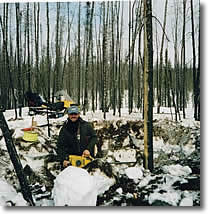 Guy Cuerrier of Soquem Inc. loading the holes with explosives. |
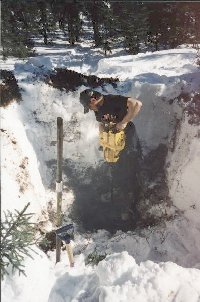 |
|
|
|
||
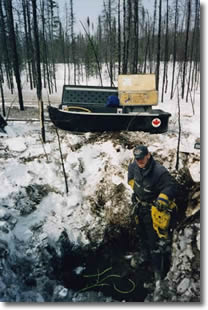 |
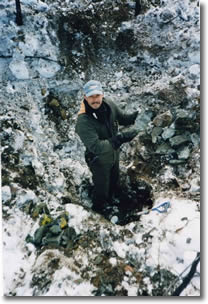 |
|
|
Cuerrier looking at another conductor about to be blasted. All the equipment is moved fast and easily with the help of a sleigh.. |
Guy Cuerrier of Soquem Inc. smiling at a massive sulfide sample picked up after blasting and ready to be sent for assay.. |
Prospecting Turkey
